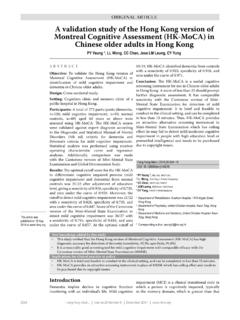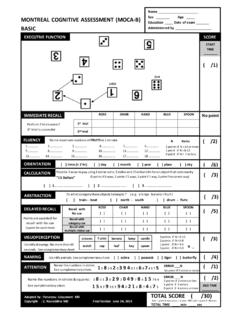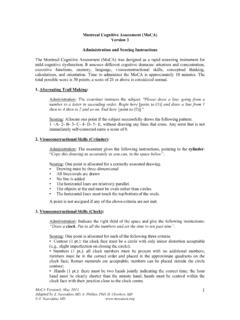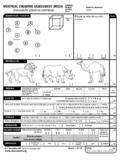Transcription of PRESERVE STUDY NEUROPSYCHOLOGICAL …
1 Version 2 8thJune 2012 Page 1 of 23 PRESERVE STUDYNEUROPSYCHOLOGICAL TESTING, DISABILITYAND QUALITY OF LIFE QUESTIONNAIRES PROCEDURES DOCUMENTV ersion 2 8thJune 2012 This section will lead you through the procedures that you need to complete theneuropsychological tests and general notes concerning NEUROPSYCHOLOGICAL testingWhen carrying out psychological tests, there are a number of issues that the test administratorneeds to carefully consider:When using a NEUROPSYCHOLOGICAL test it is important that all administrators are employing thetest in the same variations in how the instructions are given can lead to large differences inindividual scores. It is therefore essential that the test administrator is familiar with theinstructions and so is able to able to administer the test instructions you use should not be altered from those provided and it is better to readthem out rather than rely on , to make things more pleasant for the patient, in between tests, you can makegeneral comments to the patients, providing this does not distract them.
2 You can also explainto the patient you are using set instructions and tell them when you are about to do so. Thispreserves the rapport with the patient is an individual and the approaches they have to completing the tests will bevaried. For example, you may find that some participants will be very confident and startresponding before you have finished reading the instructions, whilst others will be nervousabout completing the tests and may need reassurance. It is useful to think about how youwould deal with these two types of patients whilst, nevertheless, making sure that you are stillable to follow the specified procedures. It might be useful to note down your ideas about thiswhen learning the test has been observed that some people may less readily engage with the purpose of theassessment such that more time may be needed to ensure a mutual understanding about thesession and procedures.
3 The person administering tests should try to be encouraging andsupportive, also helping the person to deal with stress and anxiety. It is worth spending moretime in establishing rapport and providing the patient with a sense that they are valued andunderstood. Care should be taken to monitor levels of anxiety and frustration and respond tothese by adjusting the style of assessment . For example, an anxious patient is helped by acalm unhurried approach. A sympathetic response may mitigate and defuse the effects 2 8thJune 2012 Page 2 of 23In the context of patients who may have NEUROPSYCHOLOGICAL symptoms, a commonexperience is a negative response to failure in which the patient may become defensive, witheven subsequent test refusal. Sometimes, attempting NEUROPSYCHOLOGICAL tests can triggergreater awareness about NEUROPSYCHOLOGICAL difficulties leading to an emotional reaction.
4 Thetests selected are designed to be relatively straightforward for the person to minimise thechances of this happening, but the administrator should be aware of the possibility ofnegative reactions. A sympathetic response, friendly encouragement or taking a short breakcan help in this further factor, frequently overlooked, is the effect of hearing loss or problems with eyesighton NEUROPSYCHOLOGICAL test performance. Hearing speech in noisy environments is known tofurther compromise performance and this should be taken into account when choosing alocation for NEUROPSYCHOLOGICAL assessments. To mitigate against hearing loss the cliniciancan speak more loudly, but without raising the pitch of the voice; care can be taken to ensurethat if the person has a hearing aid it is being used and is working properly.
5 Visual loss isquite prevalent in older adults even beyond obvious causes such as cataracts, maculardegeneration and glaucoma, and include reductions in contrast sensitivity, visual acuity andvisual processing compensate for these factors, tests designed specifically for usewith older adults tend to use larger material, with the emphasis on clarity. An obvious thingto check is whether a patient needs reading glasses and has them for the assessment . Patientsshould be reminded to bring their glasses for the that all tests are administered to the patientwith the exceptionof the DAD whichcanonlybe completed by a carer/informant who knows the patient sufficiently well to ensure it iscompleted to do firstThe first stage in becoming proficient at test administration is to familiarise yourself with thetest instructions.
6 As indicated earlier, it is essential for test instructions to be accurate. Thebest way to do this is to read carefully through the test instructions and try them out onfriends and colleagues (do this on at least 3 people). After you have done this you should notedown any queries that you have. Practice will help make the assessment more accurate butalso relaxed for the tests require you to time how long has been taken or have time limits. Timing must bedone accurately or it invalidates the test. A stopwatch should be used. Some people now usetheir mobile phone which has a timer. If so, ensure the phone is in flight familiar with how to record the patients' performance and ensure this is done test has instructions concerning how to do this and how to record the patients these scores will be entered into the research database centrally, it is important todo preliminary scoring to ensure the quality of the data 2 8thJune 2012 Page 3 of 23 Order of Tests and QuestionnairesUse a fixed order for the tests and questionnaires as below:1.
7 Disability assessment for Dementia (DAD) (this is administered through a caregiver)2. montreal cognitive assessment ( moca )3. National Adult Reading Test-Restandardised (NART-R) (administered at Baseline only)4. Rey Auditory Verbal Learning Test (RAVLT)5. Wechsler Coding (Coding)6. Trail Making Test (Trail Making)7. Verbal Fluency (VF)8. Stroke Specific Quality of Life Scale (ss-QOL)9. EuroQol (EQ-5D)Please write the Participant ID and date administered on each test. Do not add the patient sname or other identifiable details.(For the Wechsler Coding and tests, please add the Participant ID where it asks for name onthe front of the booklet).Version 2 8thJune 2012 Page 4 of 231. Disability assessment for Dementia (DAD)Instructions:The DAD is administered through an interview with an informant/caregiver who has sufficientknowledge of the patient to ensure it can be completed accurately.
8 The DAD is a measure of theactual performance in ADL of the individual as observed over a period of 2 weeks previous to thetime of the addition, the questionnaire assesses what the individual is doing and not what he/she is or might becapable of doing. These activities are evaluated as performed without any assistance or reminderbeing provided from caregivers. This must be kept in mind when administering the questionnaire sothat questions are formulated and clarified in this should be asked as stated in the questionnaire and if clarifications are needed they shouldbe given in a language that is understandable by the should be given as follows:During the past two weeks, did <patient s name>, without help or reminder,.. <undertake to washhimself/herself or to take a bath or a shower>?
9 It is essential to use the exact wording in order to keep the questionnaire the same for everybody andso get reliable in brackets should be read. The choice of answer (Yes, No, Not Applicable) should bespecified at the beginning of the interview and should be repeated throughout. Noting that somethingis Not Applicable should only be used if this really is the case; for example, it would apply to the itemabout taking medication appropriately if the patient is not prescribed any medication. In cases wherethe patient has not performed a task, however, the answer No is appropriate (see also scoring box).There is no strict order to follow for the administration of the items within each :Each item can be scored: YES = 1 point; NO = 0 points; NA = non applicableA YES indicates that the person has performed the activity without help or reminder in thelast two weeks even if it was only performed once.
10 A NO signifies that the person did notperform the activity without help or reminder. Therefore if a person has performed theactivity with some assistance from the caregiver, verbal or physical, he/she is scored as a the scores for each of the three categories Initiation, Planning/Organisationand Effective Performance and record these totals on the total and record the number of questions answered NA for each of 2 8thJune 2012 Page 5 of 232. montreal cognitive assessment ( moca )The materials for this test are on one sheet of paper. You will need a pencil and a stopwatchfor this test. On the left of each sheet is a general heading ( Visuospatial Executive) foreach stage of the moca . The instructions below refer to these different stages in order. Theinstructions indicate how to record the patient s score, which can be entered for each test inthe gap between the square brackets.









